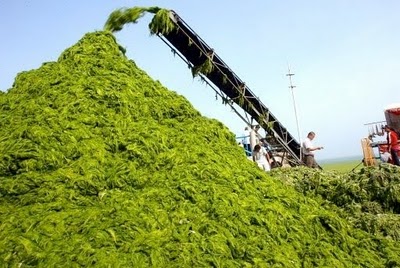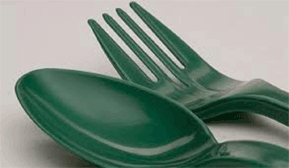
Microfarming algae offer a real solution to America’s farmers. It’s no secret that America’s family and small scale farms are disappearing fast. Mega-farms, corporate farms, high oil prices, high prices for fertilizer and animal feed, are all coming together to force many small scale farms out of business.
Without family and small scale farms and ranches, this country is changed forever. We’re already witnessing what happens when multi-nationals get control of our oil supply. Do we really want a mega-corporations in charge of our food supply too?
Now lets imagine another algae microfarming scenario…
Imagine a farmer with the ability to create his own fuel. He can do this on his currently unusable land, or even in his barn. This same farmer, using the same machine could also produce his own fertilizer and animal feed as a by-product of this fuel production.
- No more outrageous fuel prices grabbing eating into his profit.
- Those same fuel prices also force up the price of fertilizer. Cancel that order too.
- Animal feed also uses those very same inputs. Nope. Don’t need those anymore either.
Is the picture starting to look any brighter?

Imagine what a farmer could do inside a barn with a scaled PBR, or microfarming algae on non-arable land with an open pond. This also doesn’t take into account money saved on animal feed and/or fertilizers, especially for an organic urban farmer.
Localized food production is also going to have to come to pass. Very soon petrol is going to be too expensive for coast to coast trucking. I’ve seen reliable business plans in which a farmer could realize $6,000/acre “microfarming” algae.
Few people realize that small farmers here in Iowa consider themselves lucky to get $600/acre for corn. And THAT is prime cropland and a number of very expensive inputs. From that $600 he has to pay for fuel, fertilizer, water rights, and taxes.
That farmer has to risk everything he has on the line for 6-9 months and hope that nature smiles at the end of the season.
Microfarming algae can offer a real solution to forward thinking farmers.
Scientist have many ideas about micro-farming algae since this organism is very versatile. Solutions to commercial and small-scale growing systems will produce high-value and affordable food,fuels, fodder, fertilizers and medicines from algae
Investing in algae micro farming technology will further develop algae for food,fuels, fodder, fertilizers and medicines.
According to algae industry magazine, algae can provide break-through technologies on a wide range of issues. Both home and abroad, the world is searching for solutions algae can provide. Such as...

Food: Algae supply high-protein, low-fat, nutritious and healthy human foods.
Fodder: Algae produce high-protein, low-cost animal feed with numerous vitamins, minerals and nutrients. Replacing half the food grains fed to animals would save several trillion gallons of fresh water. Local algae production in villages would feed millions of animals and save many million acres a year of forests and grasslands from desertification due to animal forage.(Edwards & Algae Industry Magazine, 2010)
Ecological Solutions: Fresh water Running wastewater through algaculture feeds the plants and cleans the water. Producing fuel,fodder or fertilizer using wastewater or brine water saves water that would otherwise be used for land-based crops. According to research of alga industries in the United States,foods based on algae would save 30 million acres of cropland, 2 trillion gallons of water and 5 billion gallons of fossil fuel.
Fresh air: Flueing smoke stack gasses through algaculture removes CO2, nitric oxides, sulfur and heavy metals such as mercury from power plants or industrial plants, sequesters greenhouse gasses and cleans the air. Algae represent only a partial solution since the plant only grows with sunshine, while power plants operate 24 hours a day. Some producers have reported success with grow lights for night production.
Fine medicines: High-quality, affordable medicines, vaccines and pharmaceuticals may be made from algal co-products or grown in algae,which are bioengineered to produce advanced compounds such as antibiotics, vitamins, nutraceuticals and vaccines.
These compounds are grown today inland plants and animals. Microfarming algae offer prospects of significantly faster and lower cost production. Designer algae grown locally in villages could save millions of lives by providing low cost vaccines or other medicines that need no packaging or distribution.
Food for the hungry: American and European foreign aid provides subsidized food, undermines or destroys local food production because farmers cannot compete with subsidized food. Gifting food fails to address the root cause of hunger and poverty–local lack of domestic control over food resources and poor community engagement.

Fabrics Algal carbohydrates are similar to wood and may be made into textiles, paper and building materials. Algal paper and building materials save forests. Fabrics from algae save crop landfor food crops. Algae may be made into biodegradable plastics, biofuels or other refined products.
Fertilizer Nitrogen-fixing algae may provide high nitrogen fertilizers at very low cost in both production and energy inputs. The product is natural, supports organic food production and can provide cheap local fertilizer to subsistence farmers globally. The algal ash retains fertilizer value after being burned in cooking fires.
Fresh water: Running wastewater through algaculture feeds the plants and cleans the water. Producing fuel,fodder or fertilizer using wastewater or brine water saves water that would otherwise be used for land-based crops.
Fuel: Algal oils pressed directly from algal biomass produce renewable and sustainable, high energy biofuel from sunshine, C02 and wastewater. In the United States corn for ethanol production takes much agricultural land, water and farm input. Replacing corn with algae as a biofuel feedstock would save millions of acres,trillions of liters of irrigation water, and it would vastly reduce soil erosion and water pollution.
Microfarming algae offers a number of present day solutions to a variety of environmental, business, personal, and medicinal issues facing us today.
You also be interested in...

Algae Animal Feed
Most algae have a natural high protein content while a high oil content is mostly achieved though manipulation of cultivation conditions. Read More

Algae Bioplastics
“The day where we hit 95 dollars a barrel I think all of a sudden you’re going to see algae bio-plastics basically explode,” That day has come...Read More

Algae in Aquaculture
From fish farms to fish food, algae aquaculture is booming. With the rising price of fish food many aquaculturists are growing their own...Read More
The Algae Revolution Has Begun
You have demonstrated this is not complex. We can do this.
Dear David,
I am a small farmer that is suffering from the Economic downturn and would not have had the finances to afford it at this time. I believe your work in research on algae and your willingness to share with us maybe at the center of new world wide wealth for the under privileged. The greatest aspect of your work is the empowering of the little people. You’re making us aware we have other choices, we will no longer in bondage the big energy companies. You have demonstrated this is not complex. We can do this.
Oregon, USA



